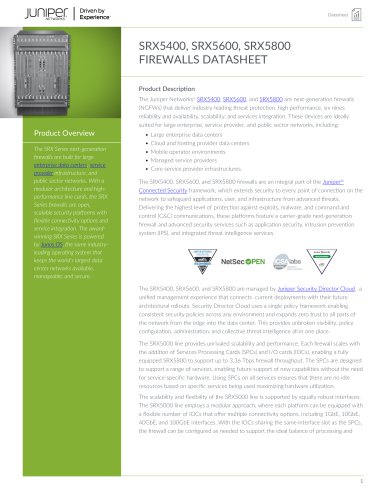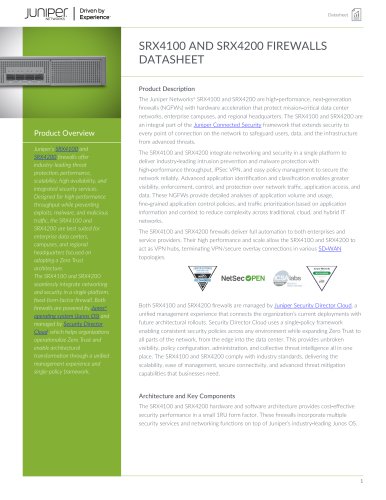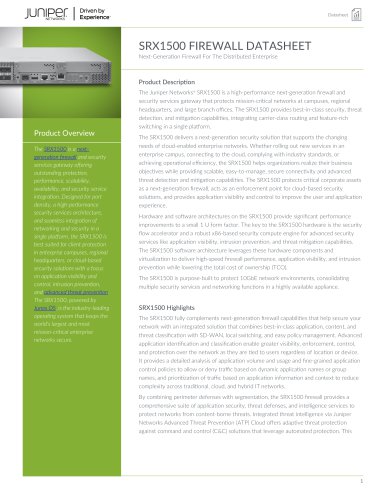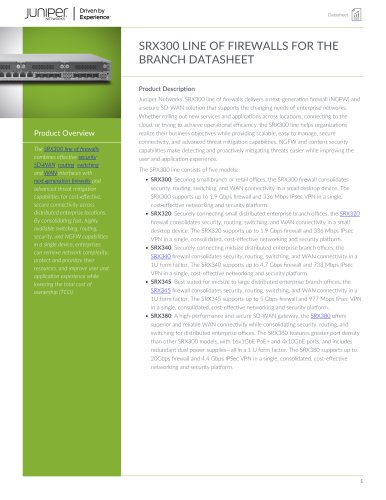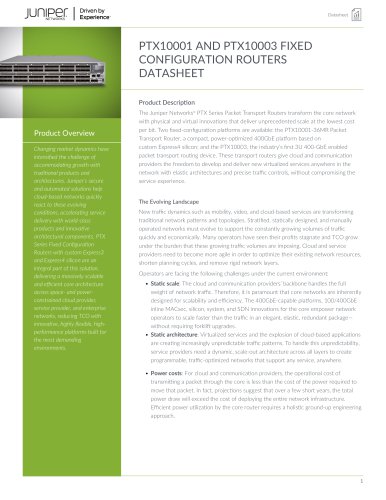
Catalog excerpts

QFABRIC SYSTEM Product Overview Modern data centers demand scale, performance, flexibility, and control— along with reductions in total cost of ownership (TCO). Juniper Networks QFabric architecture is a revolutionary approach that provides a foundation for cloud-ready virtualized data center network environments. Juniper Networks QFabric System is the cornerstone of the QFabric architecture—a purpose-built solution that allows the creation of highperformance, scalable, cost-effective, dynamic, and easy to manage large enterprise IT or service provider cloud data centers. Product Description Juniper Networks® QFabric™ System is the only fabric solution that delivers any-to-any connectivity and simplified operations, making it the ideal architectural foundation for virtualized data centers today and for the next decade. It is a scalable, high-performance, non-blocking, and easy-to-manage fabric that enables traditional Layer 2 and Layer 3 connectivity along with virtualization and convergence. The standards-based QFabric System is completely interoperable and seamlessly integrates with customers’ existing data center environments, allowing them to easily migrate traditional tiered networks to a single tier QFabric architecture that connects compute, storage, network, and services resources as extensions of a low latency network. QFabric technology enables customers to maximize the performance of their data centers and simplify their network operations. By providing direct connectivity and predictable high performance at scale between any two ports in the fabric, common changes in the data center such as adding capacity, virtual machine mobility, or deploying new applications can be achieved quickly and easily. Two QFabric System models are available: • The QFX3000-M QFabric System, designed for mid-tier, satellite, and container data center environments, supports from 48 to 768 10GbE ports, delivering the simplicity, agility, and performance benefits of QFabric architecture in a space optimized form factor. The QFX3000-M is ideal for High Performance Computing environments, Big Data Hadoop clusters, and back-end business applications, and it provides investment protection by allowing customers to easily scale to a larger QFabric system deployment as demands for 10GbE grow. • The QFX3000-G QFabric System, designed for large enterprises, service providers, and cloud data center environments, scales to support up to 6,144 10GbE ports in a single device. The QFX3000-G is ideal for cloud (IaaS, SaaS), large enterprise IT data center (business applications, data analytics), and High Performance Computing (grid computing, data modeling, scientific research) environments.
Open the catalog to page 1
• QFabric Director: The Routing Engines embedded within a modular switch are externalized in the QFabric system via the QFX3100 QFabric Director, which provides control and management services for the fabric. Deployed in clusters to provide redundancy, QFabric Directors provide a single management interface to manage the scalable data plane provided by the Node and Interconnect devices. Figure 1: The QFX3000-M system topological view QFabric Interconnect QFX3008-I The QFabric Node and QFabric Interconnect devices together create the distributed data plane for the QFabric System over which...
Open the catalog to page 2
This out-of-band network is used for auto-discovery of all devices, provisioning, image upgrades for various elements in the system, and configuration. All of these functions are fully automated and do not require user configuration. • Management plane: The Director provides all management services for the QFabric architecture, communicating directly with all Node and Interconnect devices to build a global view of the entire network. This provides a single point of visibility, control, and management for the entire data center fabric, and it significantly reduces the operational costs...
Open the catalog to page 3
QFabric System Features and Benefits Feature Multi-terabit capacity and scalability The QFabric architecture allows for scale and incremental growth by adding a QFabric Node when a new server rack is installed. With the QFabric Interconnect acting as the network backplane with a capacity of 5.12 Tbps in a QFX3000-M system and 40 Tbps in a QFX3000-G system, the QFabric architecture scales to support up to 6,144 10GbE ports, with the ability to scale beyond 10GbE in the future for both types of systems. The incremental investment required to connect new server and storage capacity is a...
Open the catalog to page 4
QFabric Architecture Management Capabilities The following system management options are available for the QFabric system: • The standard Junos OS CLI and SNMP module offers the same granular management capabilities and scripting parameters found in any router or switch powered by Junos OS. • Performance, configuration, and fault data for the QFabric architecture can also be exported to leading third-party management systems such as HP OpenView, IBM Tivoli, and Computer Associates Unicenter software, providing a complete, consolidated view of network operations. • QFabric technology is...
Open the catalog to page 5
Specifications (continued) Attribute Front to back Back to front Front to back Back to front Front to back Back to front Rack mount options 4-pole rack mount 2-pole mid mount 4-pole rack mount 2-pole mid-mount Operating altitude range 4-pole rack mount 2-pole mid mount 10,000 ft (3,048 m) counters, assign forwarding class, permit, drop, police, mark • VLAN—IEEE 802.1Q VLAN trunking • Routed VLAN interface (RVI) • Local proxy Address Resolution Protocol (ARP) • Port-based VLAN • Storm control, port error disable, and auto-recovery • Static MAC address assignment for interface • Control plane...
Open the catalog to page 6
Specifications (continued) Fibre Channel over Ethernet (FCoE) • FCoE transit switch (FIP snooping) • FCoE-FC gateway • LANs: 4,096 active; 4,090 configurable V • iSCSI transit switch (iSCSI tlv) • umber of LAGs: 48 per QFabric Node N Fiber Channel Standard • ibre Channel port speeds—2, 4, 8 Gbps F • ibre Channel port types—N_Port and VF_Port (fabric only mode) F • ibre Channel classes of service—Class 3 F • ibre Channel services—N_Port Virtualizer Device (FCoE to FC) F • umbo frame: 9,216 bytes J Layer 3 • RVIs: 2,000 • Pv4 unicast routes: 16,000 for QFabric architecture I • ibre Channel...
Open the catalog to page 7All Juniper Networks catalogs and technical brochures
-
SRX1500 FIREWALL DATASHEET
6 Pages
-
EX2300-C COMPACT ETHERNET SWITCH
10 Pages
-
EX3400 ETHERNET SWITCH
13 Pages
-
EX4300 LINE OF ETHERNET SWITCHES
17 Pages
-
EX4600 ETHERNET SWITCH
13 Pages
-
EX4650 Ethernet Switch
13 Pages
-
EX9200 Ethernet Switch
15 Pages
-
EX9250 Ethernet Switch
12 Pages
-
EX2300 ETHERNET SWITCH
12 Pages
-
QFX5200 SWITCH
13 Pages
-
QFX5210 SWITCH
9 Pages
-
ISG Series
11 Pages
Archived catalogs
-
AP550
2 Pages
-
AP250
2 Pages
-
AP150W
2 Pages
-
AP245X
2 Pages
-
JSA7500
8 Pages
-
LN1000 Mobile Secure Router
6 Pages
-
JSA Series Secure Analytics
12 Pages
-
EX4550 Ethernet Switch
12 Pages
-
EX4300 Ethernet Switch
12 Pages
-
WLA Series Antenna Matrix
2 Pages
-
QFX3100 QFabric Director
4 Pages
-
EX Series Ethernet Switches
20 Pages
-
QFX3500 Switch
12 Pages
-
QFX3600 Switch
12 Pages
-
QFX5100 Ethernet Switch
12 Pages
-
Unified Access Control
12 Pages
-
DDoS Secure
4 Pages
-
LN2600 Rugged Secure Router
6 Pages
-
1100018
6 Pages
-
1000195
6 Pages
-
1000300
4 Pages
-
backgrounder
4 Pages
-
VXA Series
4 Pages
-
SRX1400 Services Gateway
8 Pages
-
Security Services Gateways
8 Pages
-
T Series Core Routers
8 Pages
-
JCS1200 Control System
6 Pages
-
J Series Services Routers
16 Pages
-
BX7000 Multi-Access Gateway
4 Pages




